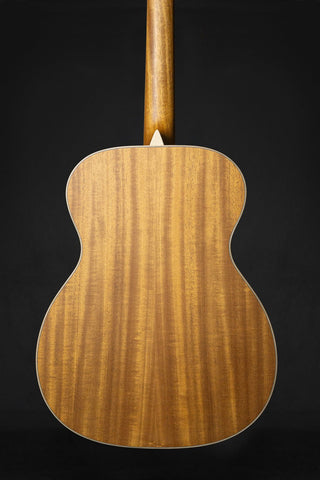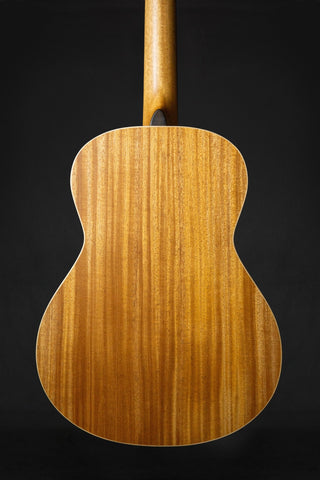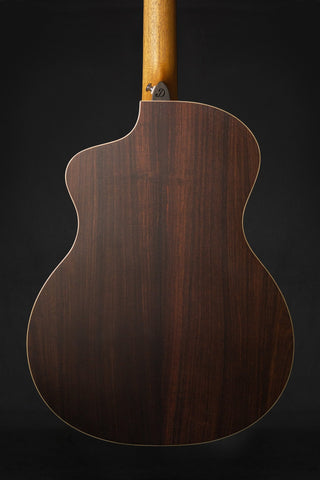There are several species of Mahogany that are commonly used for acoustic guitar back and sides, each with its own unique characteristics. The two primary species are Swietenia and Khaya, which are often referred to as American Mahogany and African Mahogany, respectively. Here's an overview of each:
-
Swietenia Mahogany (American Mahogany):

- Scientific Name: Swietenia spp. (primarily Swietenia macrophylla and Swietenia mahagoni)
- Origin: Native to the Americas, primarily found in Central and South America, including countries like Mexico, Honduras, Brazil, and Peru.
- Characteristics: Swietenia Mahogany typically has a reddish-brown to deep reddish-brown color with a straight, interlocking grain pattern. It has a medium texture and is relatively easy to work with, making it a popular choice for instrument-making.
- Tone: American Mahogany is known for its warm, balanced tone with a strong midrange presence. It offers good sustain and clarity, making it suitable for a variety of playing styles, from fingerstyle to strumming.
- Availability: Swietenia Mahogany has faced significant pressures from overharvesting and habitat loss, leading to restrictions on its trade and conservation efforts to ensure its sustainability.
-
Khaya Mahogany (African Mahogany):

- Scientific Name: Khaya spp. (primarily Khaya ivorensis, Khaya anthotheca, and Khaya senegalensis)
- Origin: Native to tropical regions of Africa, including countries like Ghana, Ivory Coast, Cameroon, and Nigeria.
- Characteristics: Khaya Mahogany varies in color from pale pinkish-brown to reddish-brown with a straight to interlocked grain pattern. It has a medium texture and is generally easier to work with compared to Swietenia Mahogany.
- Tone: African Mahogany is known for its warm, focused sound with a strong midrange and a slightly scooped character. It offers good sustain and a balanced tonal response, making it suitable for a wide range of musical styles.
- Availability: Khaya Mahogany is more readily available compared to Swietenia Mahogany and is often used as a more sustainable alternative. However, like all mahogany species, it requires responsible forestry practices to ensure its long-term availability.
Both Swietenia and Khaya Mahogany are valued for their tonal properties, ease of workability, and aesthetic appeal, making them popular choices for guitar back and sides. The choice between the two often comes down to personal preference, as well as considerations such as availability, sustainability, and budget.
Rosewood is a highly valued tonewood known for its rich, complex tone and beautiful aesthetic. There are several species of Rosewood commonly used for acoustic guitar back and sides, each with its own unique characteristics. Here's an overview of some of the main species:
-
Indian Rosewood:

- Scientific Name: Dalbergia latifolia
- Origin: Native to the Indian subcontinent, primarily found in India, Sri Lanka, and Indonesia.
- Characteristics: Indian Rosewood typically features dark brown to purplish-brown hues with darker streaks or grain patterns. It has a dense, medium texture with a straight to interlocked grain pattern. Indian Rosewood is prized for its stability, workability, and ability to take a high polish.
- Tone: Indian Rosewood is known for its rich, complex tone with a strong bass response, clear trebles, and a balanced midrange. It offers excellent projection, sustain, and harmonic overtones, making it suitable for a wide range of playing styles.
-
Availability: Indian Rosewood has faced sustainability concerns due to overharvesting and habitat loss. As a result, it is subject to international trade regulations, and responsible sourcing practices are essential to ensure its long-term availability.
-
Brazilian Rosewood:
- Scientific Name: Dalbergia nigra
- Origin: Native to Brazil and other parts of South America.
- Characteristics: Brazilian Rosewood is highly prized for its rich, chocolate-brown color with darker streaks and an incredibly fine, straight grain pattern. It has a dense, oily texture and a lustrous finish. Brazilian Rosewood is considered one of the most beautiful and tonally superior woods available for guitars.
- Tone: Brazilian Rosewood is renowned for its exceptional tonal properties, characterized by a deep, resonant bass, sparkling trebles, and a warm, complex midrange. It offers unparalleled richness, depth, and sustain, making it highly sought after by professional musicians.
-
Availability: Brazilian Rosewood has been heavily exploited over the years, leading to severe depletion of natural populations. It is now protected under CITES (Convention on International Trade in Endangered Species of Wild Fauna and Flora), and its use in instrument making is highly restricted. Vintage instruments made from Brazilian Rosewood are highly coveted and often command premium prices.
-
East Indian Rosewood:

- Scientific Name: Dalbergia sissoo
- Origin: Native to the Indian subcontinent, primarily found in India and Bangladesh.
- Characteristics: East Indian Rosewood has a wide range of color variations, including light golden-brown to dark purplish-brown hues. It features a straight to interlocked grain pattern with occasional figuring. East Indian Rosewood has good working properties and takes a smooth finish.
- Tone: East Indian Rosewood offers a warm, rich tone with a pronounced bass response, clear trebles, and a balanced midrange. It provides excellent sustain and projection, making it a popular choice for acoustic guitars.
- Availability: While East Indian Rosewood is more readily available compared to Brazilian Rosewood, it still requires responsible sourcing practices to ensure sustainability. Like Indian Rosewood, it is subject to international trade regulations to prevent overexploitation.
In summary, Rosewood species such as Indian Rosewood, Brazilian Rosewood, and East Indian Rosewood are prized for their exceptional tonal qualities, aesthetic beauty, and workability. Each species offers its own unique characteristics, making them popular choices for guitar back and sides among luthiers and musicians worldwide. However, due to sustainability concerns, responsible sourcing practices are crucial to ensure the continued availability of these valuable tonewoods.
Here's a comprehensive comparison between Mahogany and Rosewood, including various species within each wood type, to help you choose the right wood for your needs:
-
Tone:
- Mahogany: Offers a warm, focused sound with a strong midrange presence and good sustain. Varieties like Swietenia Mahogany (American) tend to have a slightly brighter tone compared to Khaya Mahogany (African).
-
Rosewood: Provides a rich, complex tone with pronounced bass response, clear trebles, and balanced midrange. Brazilian Rosewood is renowned for its exceptional tonal properties, while Indian Rosewood and East Indian Rosewood offer similar tonal characteristics with varying aesthetics.
-
Aesthetic:
- Mahogany: Features a uniform grain pattern with variations in color from light reddish-brown to deep reddish-brown. It offers an understated yet elegant appearance.
-
Rosewood: Exhibits darker hues with striking grain patterns, ranging from dark brown to purplish-brown (Indian Rosewood) or chocolate-brown (Brazilian Rosewood). Each species of Rosewood offers its own unique aesthetic appeal, from the subtle elegance of Indian Rosewood to the dramatic beauty of Brazilian Rosewood.
-
Availability and Sustainability:
- Mahogany: Khaya Mahogany (African) is generally more readily available and sustainable compared to Swietenia Mahogany (American), which has faced depletion and trade restrictions.
-
Rosewood: Indian Rosewood and East Indian Rosewood are more commonly available compared to Brazilian Rosewood, which is highly restricted due to conservation concerns and trade regulations.
-
Price:
- Mahogany: Generally more affordable compared to Rosewood, making it a popular choice for budget-conscious guitarists.
-
Rosewood: Tends to be more expensive due to its superior tonal properties and limited availability, especially Brazilian Rosewood.
-
Suitability for Playing Styles:
- Mahogany: Well-suited for a wide range of playing styles, from fingerstyle to strumming, with its warm, balanced tone.
-
Rosewood: Offers versatility across different musical genres and playing techniques, with its rich, complex tone and excellent projection.
In summary, Mahogany and Rosewood each offer unique tonal characteristics, aesthetics, and price points for guitar construction. Mahogany is a great choice for those seeking a warm, balanced tone at a more affordable price, while Rosewood, particularly Brazilian Rosewood, is ideal for musicians who prioritize exceptional tonal quality and aesthetic beauty despite its higher cost and limited availability. Ultimately, the choice between Mahogany and Rosewood depends on individual preferences, playing style, budget considerations, and availability.
Written by:
Ryan Havinga







